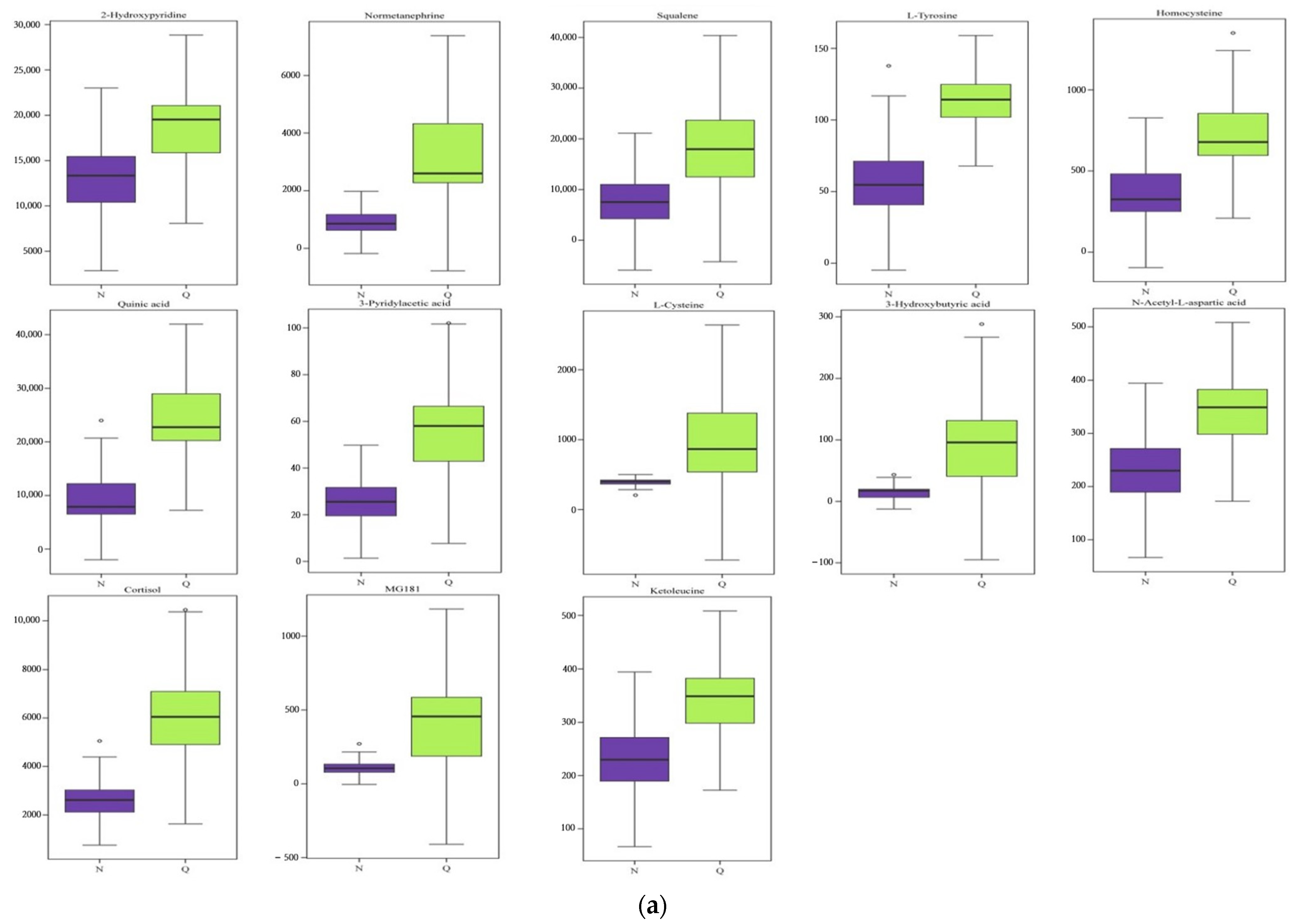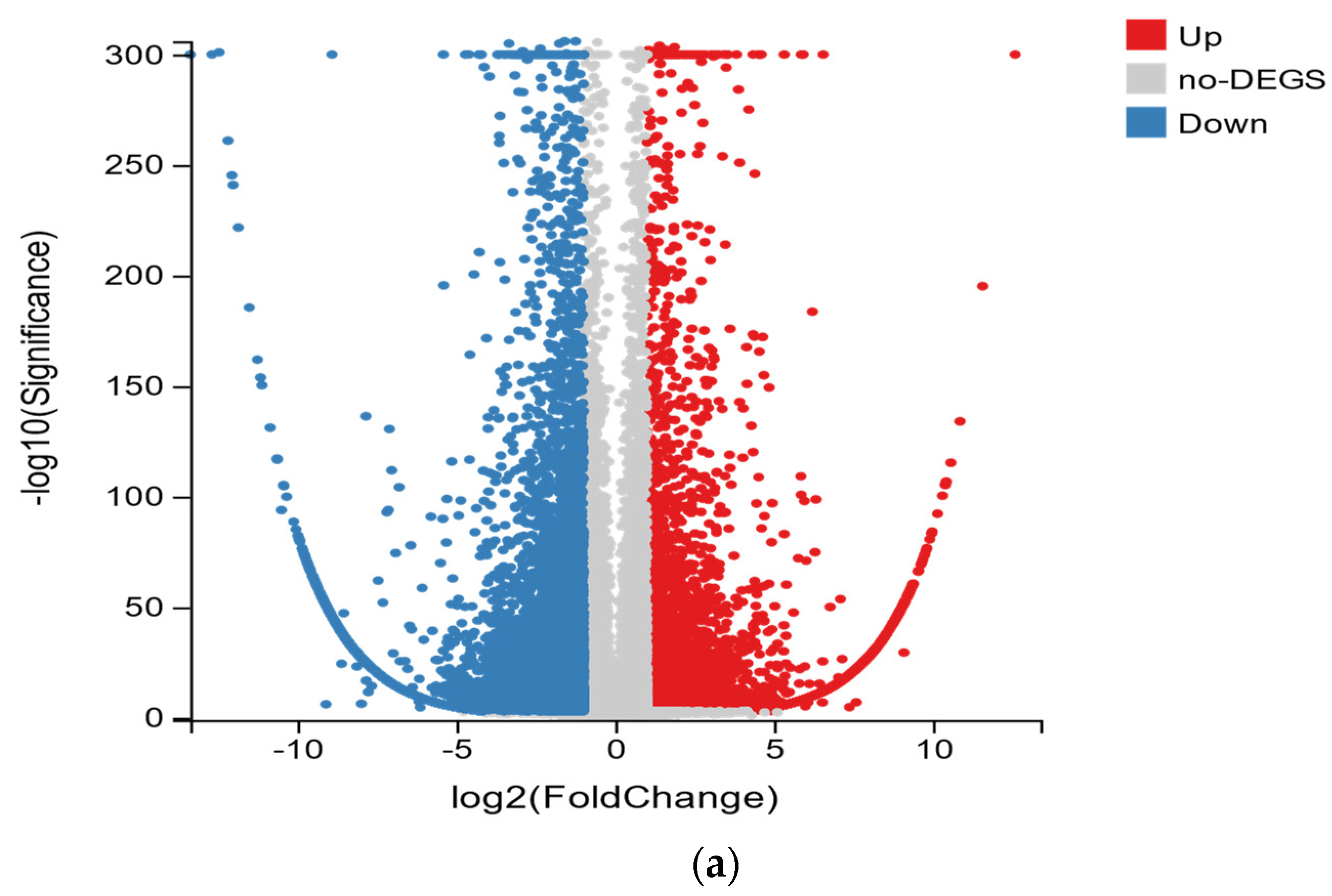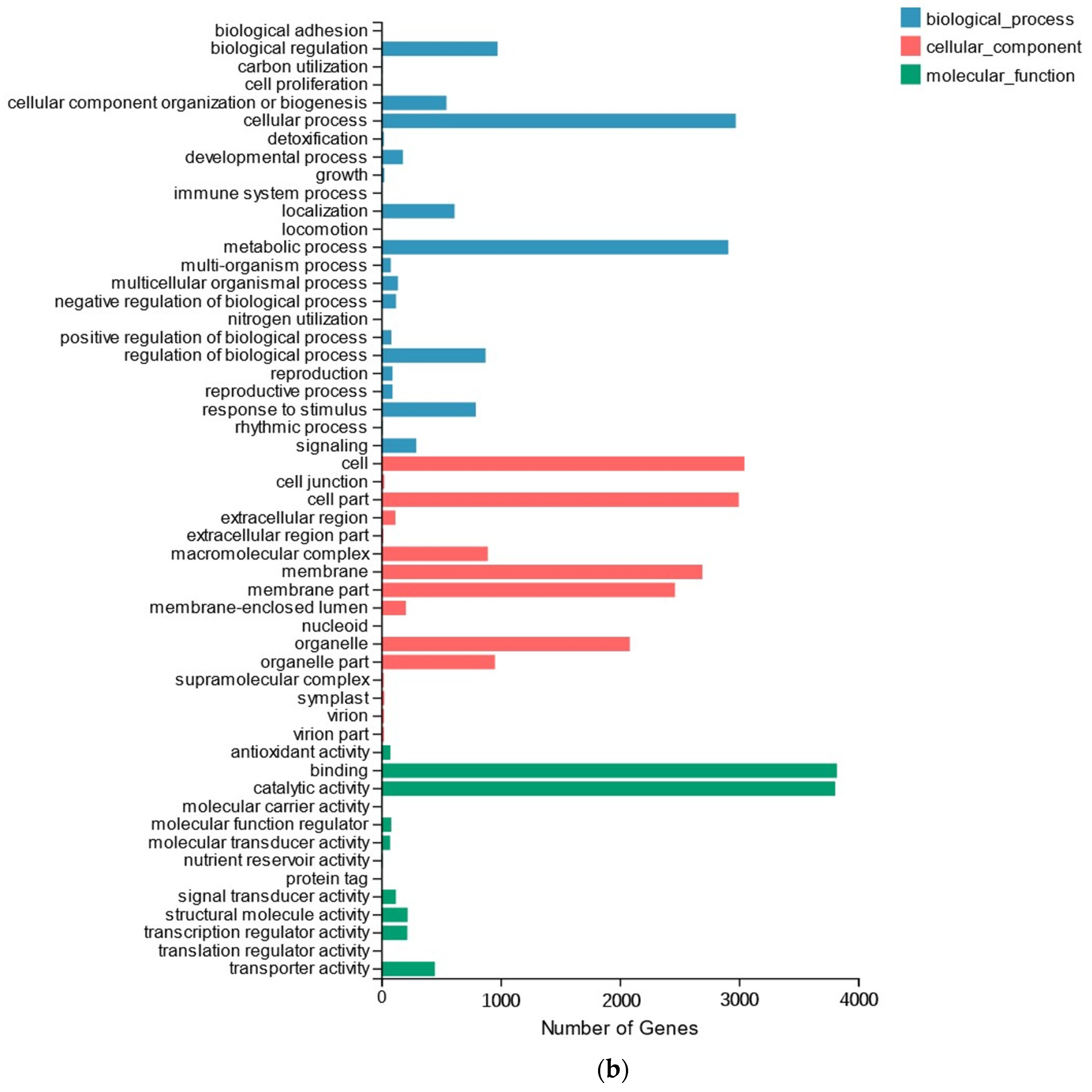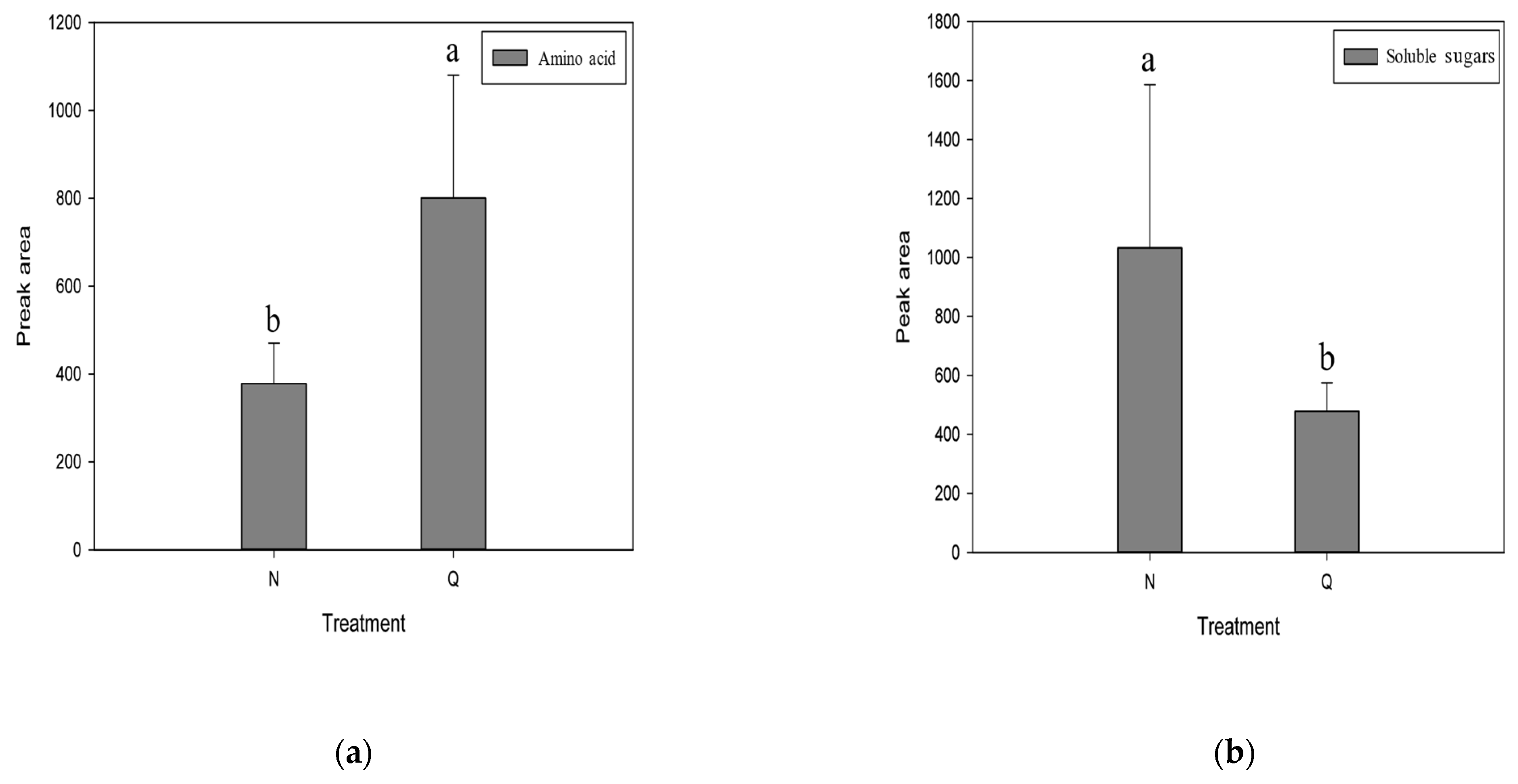UV-B Irradiation to Amino Acids and Carbohydrate Metabolism in Rhododendron chrysanthum Leaves by Coupling Deep Transcriptome and Metabolome Analysis
Abstract
1. Introduction
2. Results
2.1. Analysis of Metabolites in Rhododendron Chrysanthum
2.2. Differentially Accumulated Metabolite (DAM) Analysis of R. chrysanthum under UV-B Irradiation
2.3. Transcriptome Analysis of R. chrysanthum under UV-B Irradiation
2.4. Comprehensive Study of Metabolic Pathways of R. chrysanthum under UV-B Irradiation
2.5. Physiological Changes of Domesticated R. chrysanthum under UV-B
3. Discussion
4. Materials and Methods
4.1. Plant Materials and Treatment
4.2. Determination of Physiological Characteristics of Rhododendron under UVB Stress
4.3. Metabolite Identification and Quantification by GC-TOFMS
4.4. Metabolite Data Analysis
4.5. RNA-Seq Library Construction and Sequencing
4.6. De Novo Assembly and Sequence Annotation
4.7. Differential Expression Analysis
4.8. Statistical Analysis
5. Conclusions
Author Contributions
Funding
Institutional Review Board Statement
Informed Consent Statement
Data Availability Statement
Conflicts of Interest
References
- Mario, J.; Molina, F.; Rowland, S. Stratospheric sink for chlorofluoromethanes: Chlorine atom-catalysed destruction of ozone. Nature 1974, 249, 810–812. [Google Scholar]
- Heinze, M.; Hanschen, F.S.; Wiesner-Reinhold, M.; Baldermann, S.; Gräfe, J.; Schreiner, M.; Neugart, S. Effects of Develop-mental Stages and Reduced UVB and Low UV Conditions on Plant Secondary Metabolite Profiles in Pak Choi (Brassica rapa subsp chinensis). J. Agric. Food Chem. 2018, 66, 1678–1692. [Google Scholar] [CrossRef] [PubMed]
- Agrawal, S.; Mishra, S. Effects of supplemental ultraviolet-B and cadmium on growth, antioxidants and yield of Pisum sativum L. Ecotoxicol. Environ. Saf. 2009, 72, 610–618. [Google Scholar] [CrossRef] [PubMed]
- Ballare, L.C.; Caldwell, M.M.; Flint, D.S.; Barnes, W.P.; Robinson, A.S. Solar ultraviolet radiation and ozone deple-tion-driven climate change: Effects on terrestrial ecosystems. Photochem. Photobiol. Sci. 2015, 14, 88–107. [Google Scholar]
- Kuttippurath, J.; Lefèvre, F.; Pommereau, J.-P.; Roscoe, H.K.; Goutail, F.; Pazmiño, A.; Shanklin, J.D. Antarctic ozone loss in 1979–2010: First sign of ozone recovery. Atmospheric Chem. Phys. 2013, 13, 1625–1635. [Google Scholar] [CrossRef]
- Wang, F.; Xu, Z.; Fan, X.; Zhou, Q.; Cao, J.; Ji, G.; Jing, S.; Feng, B.; Wang, T. Transcriptome Analysis Reveals Complex Molecular Mechanisms Underlying UV Tolerance of Wheat (Triticum aestivum, L.). J. Agric. Food Chem. 2018, 67, 563–577. [Google Scholar] [CrossRef] [PubMed]
- Lyu, J.; Wang, C.; Liang, D.; Liu, L.; Pandey, L.; Xu, H.; Zhou, X. Sensitivity of wild and domesticated Rhododendron chrysanthum to different light regime (UVA, UVB, and PAR). Photosynthetica 2019, 57, 841–849. [Google Scholar] [CrossRef]
- Maher, M.; Ahmad, H.; Nishawy, E.; Li, Y.; Luo, J. Novel Transcriptome Study and Detection of Metabolic Variations in UV-B-Treated Date Palm (Phoenix dactylifera cv. Khalas). Int. J. Mol. Sci. 2021, 22, 2564. [Google Scholar] [CrossRef] [PubMed]
- Kusano, M.; Tohge, T.; Fukushima, A.; Kobayashi, M.; Hayashi, N.; Otsuki, H.; Kondou, Y.; Goto, H.; Kawashima, M.; Matsuda, F.; et al. Metabolomics reveals comprehensive reprogramming involving two independent metabolic responses of Arabidopsis to UV-B light. Plant J. 2011, 67, 354–369. [Google Scholar] [CrossRef] [PubMed]
- Kim, S.; Yun, E.J.; Hossain, A.; Lee, H.; Kim, K.H. Global profiling of ultraviolet-induced metabolic disruption in Melissa officinalis by using gas chromatography-mass spectrometry. Anal. Bioanal. Chem. 2012, 404, 553–562. [Google Scholar] [CrossRef] [PubMed]
- Kreslavski, V.D.; Strokina, V.V.; Khudyakova, A.Y.; Shirshikova, G.N.; Kosobryukhov, A.A.; Pashkovskiy, P.P.; Alwasel, S.; Allakhverdiev, S.I. Effect of high-intensity light and UV-B on photosynthetic activity and the expression of certain light-responsive genes in A. thaliana phyA and phyB mutants. Biochim. Biophys. Acta 2021, 1862, 148445. [Google Scholar] [CrossRef] [PubMed]
- Kopp, P.B. The genus Rhododendron: An ethnopharmacological and toxicological review. J. Ethnopharmacol. 2013, 147, 42–62. [Google Scholar]
- Zhou, X.; Chen, S.; Wu, H.; Yang, Y.; Xu, H. Biochemical and proteomics analyses of antioxidant enzymes reveal the potential stress tolerance in Rhododendron chrysanthum Pall. Biol. Direct 2017, 12, 10. [Google Scholar] [CrossRef] [PubMed]
- Mckenzie, R.L.; Aucamp, P.J.; Bais, A.F.; Björn, L.; Ilyas, M.; Madronich, S. Environmental effects of ozone depletion and its in-teractions with climate change: 2002 assessment. Photochem. Photobiol. Sci. 2003, 2, 1-vii. [Google Scholar]
- Jansen, M.A.; Gaba, V.; Greenberg, B.M. Higher plants and UV-B radiation: Balancing damage, repair and acclimation. Trends Plant Sci. 1998, 3, 131–135. [Google Scholar] [CrossRef]
- Teramura, A.H.; Sullivan, J. Effects of UV-B radiation on photosynthesis and growth of terrestrial plants. Photosynth. Res. 1994, 39, 463–473. [Google Scholar] [CrossRef]
- Martínez-Lüscher, J.; Torres, N.; Hilbert, G.; Richard, T.; Sánchez-Díaz, M.; Delrot, S.; Aguirreolea, J.; Pascual, I.; Gomès, E. Ultra-violet-B radiation modifies the quantitative and qualitative profile of flavonoids and amino acids in grape berries. Phyto-chemistry 2014, 102, 106–114. [Google Scholar]
- Singh, S.; Agrawal, S.B.; Agrawal, M. Responses of pea plants to elevated UV-B radiation at varying nutrient levels: N-metabolism, carbohydrate pool, total phenolics and yield. Funct. Plant Biol. 2015, 42, 1045–1056. [Google Scholar] [CrossRef]
- Jy, A.; Lhc, B.; Wt, A.; Jsj, A.; Ga, A. Sucrose signaling in higher plants—ScienceDirect. Plant Sci. 2020, 302. [Google Scholar] [CrossRef]
- Hu, T.; Hu, L.; Zhang, X.; Zhang, P.; Fu, J. Differential Responses of CO2 Assimilation, Carbohydrate Allocation and Gene Ex-pression to NaCl Stress in Perennial Ryegrass with Different Salt Tolerance. PLoS ONE 2013, 8, e66090. [Google Scholar]
- Savitch, L.V.; Leonardos, E.D.; Krol, M.; Jansson, S.; Grodzinski, B.; Huner, N.P.A.; Öquist, G. Two different strategies for light utilization in photosynthesis in relation to growth and cold acclimation. Plant Cell Environ. 2002, 25, 761–771. [Google Scholar] [CrossRef]
- Qiu, C.; Sun, J.; Shen, J.; Zhang, S.; Ding, Y.; Gai, Z.; Fan, K.; Song, L.; Chen, B.; Ding, Z.; et al. Fulvic acid enhances drought resistance in tea plants by regulating the starch and sucrose metabolism and certain secondary metabolism. J. Proteom. 2021, 247, 104337. [Google Scholar] [CrossRef] [PubMed]
- Hou, X.; Qi, N.; Wang, C.; Li, C.; Huang, D.; Li, Y.; Wang, N.; Liao, W. Hydrogen-rich water promotes the formation of bulblets in Lilium davidii var. unicolor through regulating sucrose and starch metabolism. Planta 2021, 254, 106. [Google Scholar] [CrossRef] [PubMed]
- Kumar, R.; Mukherjee, S.; Ayele, B.T. Molecular aspects of sucrose transport and its metabolism to starch during seed devel-opment in wheat: A comprehensive review. Biotechnol. Adv. 2018, 36, 954. [Google Scholar] [CrossRef] [PubMed]
- Dong, S.; Beckles, D.M. Dynamic changes in the starch-sugar interconversion within plant source and sink tissues promote a better abiotic stress response. J. Plant Physiol. 2019, 234–235, 80–93. [Google Scholar] [CrossRef]
- Macneill, G.J.; Sahar, M.; Minow, M.A.A.; Patterson, J.A.; Tetlow, I.J.; Emes, M.J. Starch as a source, starch as a sink: The bifunc-tional role of starch in carbon allocation. J. Exp. Bot. 2017, 68, 4433–4453. [Google Scholar] [CrossRef]
- Mookerjee, S.A.; Gerencser, A.A.; Nicholls, D.G.; Brand, M.D. Quantifying intracellular rates of glycolytic and oxidative ATP production and consumption using extracellular flux measurements. J. Biol. Chem. 2017, 292, 7189–7207. [Google Scholar] [CrossRef]
- Akram, M. Citric Acid Cycle and Role of its Intermediates in Metabolism. Cell Biochem. Biophys. 2014, 68, 475–478. [Google Scholar] [CrossRef]
- Zhang, X.; Ding, X.; Ji, Y.; Wang, S.; Chen, Y. Measurement of metabolite variations and analysis of related gene expression in Chinese liquorice (Glycyrrhiza uralensis) plants under UV-B irradiation. Sci. Rep. 2018, 8, 6144. [Google Scholar] [CrossRef]
- Galili, G. The aspartate-family pathway of plants: Linking production of essential amino acids with energy and stress regu-lation. Plant Signal Behav. 2011, 6, 192–195. [Google Scholar] [CrossRef]
- Zhu, X.; Galili, G. Increased Lysine Synthesis Coupled with a Knockout of Its Catabolism Synergistically Boosts Lysine Content and Also Transregulates the Metabolism of Other Amino Acids in Arabidopsis Seeds. Plant Cell 2003, 15, 845–853. [Google Scholar] [CrossRef]
- Asya, S.; Gad, G. Synthesis of the Arabidopsis Bifunctional Lysine-Ketoglutarate Reductase/Saccharopine De-hydrogenase Enzyme of Lysine Catabolism Is Concertedly Regulated by Metabolic and Stress-Associated Signals. Plant Physiol. 2003, 133, 1407–1415. [Google Scholar]
- Ozkan, A.; Nevzat, E.; Icoglu, F.; Dilruba, T.; Aslihan, E. Effect of proline on biochemical and molec-ular mechanisms in lettuce (Lactuca sativa L.) exposed to UV-B radiation. Photochem. Photobiol. Sci. 2017, 16, 246–254. [Google Scholar]
- Yang, B.; Wang, X.; Gao, C.; Chen, M.; Guan, Q.; Tian, J.; Komatsu, S. Proteomic and Metabolomic Analyses of Leaf from Clem-atis terniflora DC. Exposed to High-Level Ultraviolet-B Irradiation with Dark Treatment. J. Proteome Res. 2016, 15, 2643–2657. [Google Scholar] [CrossRef] [PubMed]
- Igamberdiev, A.U.; Kleczkowski, L.A. The Glycerate and Phosphorylated Pathways of Serine Synthesis in Plants: The Branches of Plant Glycolysis Linking Carbon and Nitrogen Metabolism. Front. Plant Sci. 2018, 9, 318. [Google Scholar] [CrossRef] [PubMed]
- Hollósy, F. Effects of ultraviolet radiation on plant cells. Micron 2001, 33, 179–197. [Google Scholar] [CrossRef]
- Czégény, G.; Mátai, A.; Hideg, É. UV-B effects on leaves—Oxidative stress and acclimation in controlled environments. Plant Sci. 2016, 248, 57–63. [Google Scholar] [CrossRef] [PubMed]
- Zhou, X.; Lyu, J.; Sun, L.; Dong, J.; Xu, H. Metabolic programming of Rhododendron chysanthum leaves following exposure to UVB irradiation. Funct. Plant Biol. 2021, 48, 1175–1185. [Google Scholar] [CrossRef]
- Qiu, Y.; Cai, G.; Zhou, B.; Li, D.; Zhao, A.; Xie, G.; Li, H.; Cai, S.; Xie, D.; Huang, C.; et al. A Distinct Metabolic Signature of Human Colorectal Cancer with Prognostic Potential. Clin. Cancer Res. 2014, 20, 2136–2146. [Google Scholar] [CrossRef] [PubMed]
- Tang, H.; Zhang, X.; Gong, B.; Yan, Y.; Shi, Q. Proteomics and metabolomics analysis of tomato fruit at different maturity stages and under salt treatment. Food Chem. 2019, 311, 126009. [Google Scholar] [CrossRef]
- Xiong, Y.; Yan, P.; Du, K.; Li, M.; Xie, Y.; Gao, P. Nutritional component analyses of kiwifruit in different development stages by metabolomic and transcriptomic approaches. J. Sci. Food Agric. 2020, 100, 2399–2409. [Google Scholar] [CrossRef] [PubMed]
- Zou, S.; Wu, J.; Shahid, M.Q.; He, Y.; Lin, S.; Liu, Z.; Yang, X. Identification of key taste components in loquat using widely tar-geted metabolomics. Food Chem. 2020, 323, 126822. [Google Scholar] [CrossRef] [PubMed]
- Cao, K.; Zhang, Z.; Fan, H.; Tan, Y.; Xu, H.; Zhou, X. Comparative transcriptomic analysis reveals gene expression in response to cold stress in Rhododendron aureum Georgi. Theor. Exp. Plant Physiol. 2022, 34, 347–366. [Google Scholar] [CrossRef]







| Class | Name | KEGG ID | VIP | Corr.Coeffs. | p |
|---|---|---|---|---|---|
| Alcohols | 2-Hydroxypyridine | C02502 | 1.4 | 0.6 | 0.038 |
| Alkylamines | Putrescine | C00134 | 1.7 | −0.69 | 0.014 |
| Amino Acid | L-Methionine | C00073 | 1.6 | −0.65 | 0.021 |
| L-Cysteine | C00097 | 1.6 | 0.65 | 0.022 | |
| 3-Nitrotyrosine | NA | 1.5 | −0.64 | 0.026 | |
| Ketoleucine | C00233 | 1.5 | 0.63 | 0.027 | |
| N-Acetyl-L-aspartic acid | C01042 | 1.5 | 0.63 | 0.029 | |
| L-Tyrosine | C00082 | 1.5 | 0.63 | 0.029 | |
| Homocysteine | C00155 | 1.5 | 0.61 | 0.036 | |
| Carbohydrates | Ratio of D-Glucose/Sucrose | C00031/C00089 | 1.7 | −0.7 | 0.012 |
| D-Glucose | C00031 | 1.7 | −0.69 | 0.014 | |
| Salicin | C01451 | 1.5 | −0.64 | 0.026 | |
| Galactinol | C01235 | 1.4 | −0.57 | 0.055 | |
| Fructose 6-phosphate | C00085 | 1.3 | −0.56 | 0.061 | |
| Fatty Acids | Palmitoleic acid | C08362 | 1.7 | −0.7 | 0.011 |
| Myristic acid | C06424 | 1.4 | −0.56 | 0.056 | |
| Hormone | Normetanephrine | C05589 | 1.8 | 0.74 | 0.062 |
| Indoles | Indoleacetic acid | C00954 | 1.8 | −0.77 | 0.036 |
| Lipids | Cortisol | C00735 | 1.7 | 0.71 | 0.097 |
| Squalene | C00751 | 1.6 | 0.66 | 0.02 | |
| MG181 | NA | 1.6 | 0.64 | 0.024 | |
| Phytol | C01389 | 1.4 | −0.6 | 0.039 | |
| Nucleotide | Ratio of Guanine/Guanosine | C00242/C00387 | 1.7 | −0.71 | 0.01 |
| Uridine | C00299 | 1.3 | 0.53 | 0.074 | |
| Guanine | C00242 | 1.3 | −0.52 | 0.082 | |
| Organic Acids | Quinic acid | C06746 | 1.6 | 0.68 | 0.015 |
| 3-Pyridylacetic acid | NA | 1.5 | 0.64 | 0.026 | |
| 3-Hydroxybutyric acid | C01089 | 1.5 | 0.61 | 0.036 | |
| Glyceric acid | C00258 | 1.4 | 0.57 | 0.054 | |
| Methylmalonic acid | C02170 | 1.4 | 0.56 | 0.057 |
| Sample | Total Raw Reads (M) | Total Clean Reads (M) | Total Clean Bases (G) | Clean Reads Q20 (%) | Clean Reads Q30 (%) | Clean Reads Ratio (%) |
|---|---|---|---|---|---|---|
| B1 | 50.62 | 42.61 | 6.39 | 98.28 | 94.79 | 84.18 |
| B2 | 48.99 | 42.14 | 6.32 | 98.4 | 95.11 | 86.02 |
| B3 | 48.99 | 42.11 | 6.32 | 98.35 | 94.99 | 85.96 |
| C1 | 50.62 | 42.51 | 6.38 | 98.24 | 94.69 | 83.98 |
| C2 | 50.62 | 42.35 | 6.35 | 98.19 | 94.56 | 83.67 |
| C3 | 48.99 | 42.2 | 6.33 | 98.39 | 95.08 | 86.15 |
| Category | Gene ID | Log2 (FC) | Gene Annotation | N_ FPKM | Q_ FPKM |
|---|---|---|---|---|---|
| Up-regulation | CL608.Contig2_All | 2.349389594 | SUS | 12.91 | 64.39 |
| CL1718.Contig2_All | 7.224980744 | ENPP1-3 | 0 | 1.37 | |
| CL7420.Contig1_All | 2.327828344 | ENPP1-3 | 0.38 | 1.8 | |
| Unigene29857_All | 3.447712663 | ENPP1-3 | 0.32 | 3.34 | |
| CL1614.Contig2_All | 2.610055003 | glgC | 0.43 | 2.50 | |
| CL1614.Contig3_All | 2.062679357 | glgC | 2.53 | 10.51 | |
| CL7994.Contig3_All | 1.401056683 | glgC | 0.51 | 1.31 | |
| CL8178.Contig2_All | 2.248223204 | glgC | 0.33 | 1.49 | |
| Unigene13491_All | 1.025840993 | glgC | 1.34 | 2.65 | |
| CL3065.Contig5_All | 5.355483066 | HK | 0.06 | 2.29 | |
| CL3235.Contig1_All | 1.968881228 | HK | 1.36 | 5.14 | |
| CL3235.Contig2_All | 2.58685544 | HK | 1.36 | 7.99 | |
| CL6896.Contig1_All | 1.430008739 | HK | 3.90 | 10.42 | |
| CL4075.Contig6_All | 1.526486171 | CYSK | 149.10 | 427.61 | |
| Down-regulation | Unigene6196_All | −1.330036028 | WAXY | 38.85 | 15.33 |
| Unigene27695_All | −1.492972109 | WAXY | 9.40 | 3.27 | |
| CL6569.Contig4_All | −1.344077739 | GBE1 | 6.39 | 2.48 | |
| CL6569.Contig5_All | −2.859334375 | GBE1 | 5.58 | 0.76 | |
| CL6569.Contig6_All | −8.828709849 | GBE1 | 1.44 | 0 | |
| CL2240.Contig1_All | −1.733082687 | MetE | 29.76 | 8.80 | |
| CL2240.Contig2_All | −1.131730226 | MetE | 79.91 | 36.47 | |
| CL2240.Contig3_All | −1.314884433 | MetE | 12.78 | 5.11 | |
| Unigene9717_All | −4.32204255 | CCBL | 0.26 | 0 | |
| CL1477.Contig1_All | −6.471374115 | CHA1 | 0.80 | 0 |
Publisher’s Note: MDPI stays neutral with regard to jurisdictional claims in published maps and institutional affiliations. |
© 2022 by the authors. Licensee MDPI, Basel, Switzerland. This article is an open access article distributed under the terms and conditions of the Creative Commons Attribution (CC BY) license (https://creativecommons.org/licenses/by/4.0/).
Share and Cite
Sun, Q.; Liu, M.; Cao, K.; Xu, H.; Zhou, X. UV-B Irradiation to Amino Acids and Carbohydrate Metabolism in Rhododendron chrysanthum Leaves by Coupling Deep Transcriptome and Metabolome Analysis. Plants 2022, 11, 2730. https://doi.org/10.3390/plants11202730
Sun Q, Liu M, Cao K, Xu H, Zhou X. UV-B Irradiation to Amino Acids and Carbohydrate Metabolism in Rhododendron chrysanthum Leaves by Coupling Deep Transcriptome and Metabolome Analysis. Plants. 2022; 11(20):2730. https://doi.org/10.3390/plants11202730
Chicago/Turabian StyleSun, Qi, Meiqi Liu, Kun Cao, Hongwei Xu, and Xiaofu Zhou. 2022. "UV-B Irradiation to Amino Acids and Carbohydrate Metabolism in Rhododendron chrysanthum Leaves by Coupling Deep Transcriptome and Metabolome Analysis" Plants 11, no. 20: 2730. https://doi.org/10.3390/plants11202730
APA StyleSun, Q., Liu, M., Cao, K., Xu, H., & Zhou, X. (2022). UV-B Irradiation to Amino Acids and Carbohydrate Metabolism in Rhododendron chrysanthum Leaves by Coupling Deep Transcriptome and Metabolome Analysis. Plants, 11(20), 2730. https://doi.org/10.3390/plants11202730






